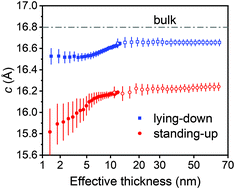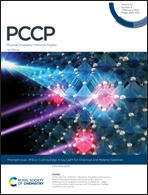Reorientation of π-conjugated molecules on few-layer MoS2 films†
Abstract
Small π-conjugated organic molecules have attracted substantial attention in the past decade as they are considered as candidates for future organic-based (opto-)electronic applications. The molecular arrangement in the organic layer is one of the crucial parameters that determine the efficiency of a given device. The desired orientation of the molecules is achieved by a proper choice of the underlying substrate and growth conditions. Typically, one underlying material supports only one inherent molecular orientation at its interface. Here, we report on two different orientations of diindenoperylene (DIP) molecules on the same underlayer, i.e. on a few-layer MoS2 substrate. We show that DIP molecules adopt a lying-down orientation when deposited on few-layer MoS2 with horizontally oriented layers. In contrast, for vertically aligned MoS2 layers, DIP molecules are arranged in a standing-up manner. Employing in situ and real-time grazing-incidence wide-angle X-ray scattering (GIWAXS), we monitored the stress evolution within the thin DIP layer from the early stages of the growth, revealing different substrate-induced phases for the two molecular orientations. Our study opens up new possibilities for the next-generation of flexible electronics, which might benefit from the combination of MoS2 layers with unique optical and electronic properties and an extensive reservoir of small organic molecules.



 Please wait while we load your content...
Please wait while we load your content...